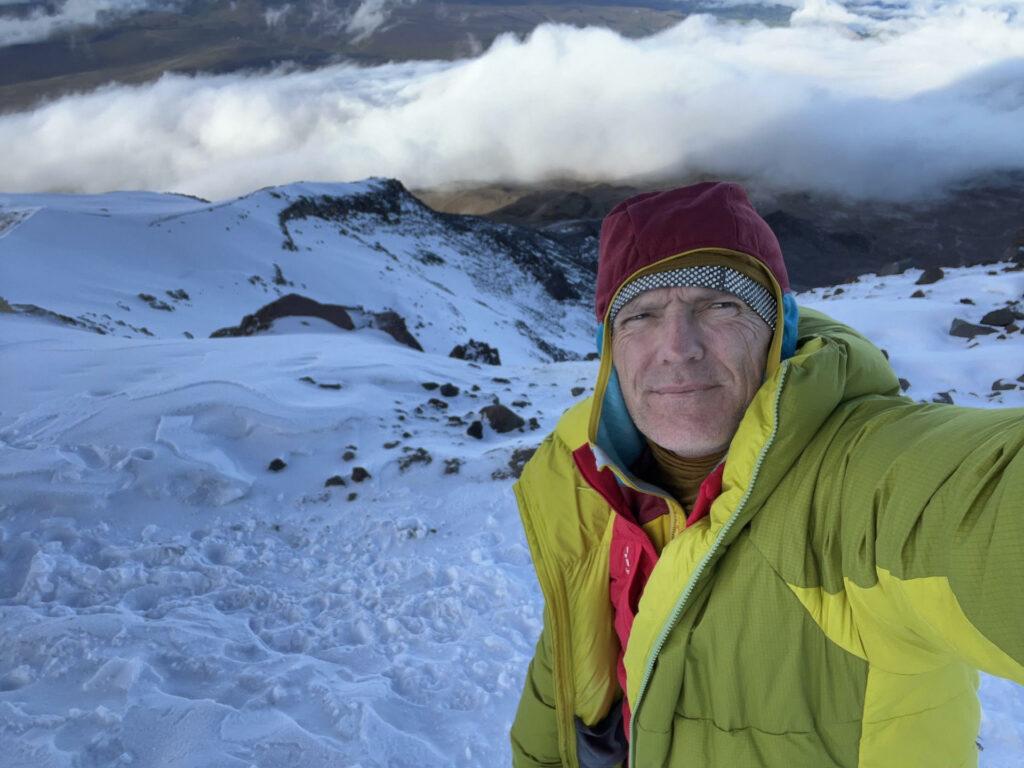Patients living with rare and chronic diseases can often find a new life purpose thanks to innovative medicines that help restore their health. Patrick Belton, aged 56, is one of those patients. The chronic disease he lives with disrupted his life for more than a decade and nearly killed him. He now has a positive new outlook on life as well as a mission: to climb the world’s tallest mountains for a good cause.
An athletic life on hold
Patrick was an active and healthy cross-country and track runner growing up in Toronto. He saw only good health in his future. At age 19, he started experiencing abdominal pain and discomfort. “I developed on-and-off intestinal issues,” he recalls. “Then it progressed to malfunctioning bowels.” Patrick got a clear diagnosis more than two years later: colitis. Colitis is a form of inflammatory bowel disease (IBD) that involves the chronic inflammation of tissues in the digestive tract.
“I dropped about 40 pounds between the ages of 19 and 21,” Patrick says. “I was weak and pale. I had all the symptoms of untreated IBD.” Patrick received treatment throughout his early twenties. He eventually received medication that controlled his disease for some time and enabled him to go back to university to finish his degree. He was in full remission by age 30.

Patrick Belton is a patient living with Crohn’s disease. This photo was taken in 2019 after he received an innovative, life-saving treatment to control the disease.
A turn for the worse
In 2003, Patrick and his wife separated and later divorced. He became a single father. “The stress brought back my health issues,” he says. Patrick’s diagnosis changed to a more severe form of IBD called Crohn’s disease. The condition involves inflammation of the deeper layers of the digestive tract. Symptoms include abdominal pain, diarrhea, rectal bleeding, fatigue, and weight loss. “By 2006, my disease became too much,” he recalls. “It was heavily affecting all facets of my life.”
Patrick had his colon removed and underwent three intestinal surgeries and an ostomy surgery in 2009. Ostomy is a life-saving procedure that creates an opening in the abdomen (called stoma) for bodily waste to exit and collect in an external pouch. The surgeries helped improve his quality of life at first, but the positives didn’t last long. “The debilitating effects of IBD, the surgeries, and health issues that arise due to a weakened immune and nervous systems, are often worse than the disease itself,” he explains. “My system was so weakened that I developed many other conditions like anemia, fractures, exhaustion, weight loss and malnutrition.”
During an emergency hospital visit, Patrick’s doctors gave him 24 hours to live. He had blood clots in his lungs and right leg. He was also severely dehydrated. While he overcame the dangerous side effects of IBD, the disease progressed. “It destroyed my career, financial stability and social life,” he says. “I lost a decade of life between 2009 and 2019.”
From hospital to mountaintop
Each traditional IBD treatment eventually stopped working for Patrick. In 2019, his doctor recommended a new drug that had recently been approved for treating IBD and Crohn’s. Within a year, Patrick’s health stabilized. “I’m so fortunate for getting a really innovative medicine for Crohn’s,” he says. “I had several close calls with death before 2019. This medicine made my symptoms disappear and put my IBD into remission. That is why having access to life-saving medicines sooner is important. It truly saved and restored my life.” With his health on the mend, he returned to physical activity bit by bit.
Patrick moved to Nova Scotia in 2020 seeking a slower pace of life. One day, while hiking by the beach, he was inspired to run the final few kilometres. “That day, I realized I was back,” he admits. “I was confident in my body again. I didn’t have to worry about getting sick anymore. I could look forward to tackling life once again.”
Patrick started travelling to Alberta (where he now spends several months of the year) and British Columbia to take up mountain climbing. While climbing B.C.’s Black Tusk Mountain in 2021, he decided that he would dedicate his restored athletic ability to helping people in the IBD and ostomy communities.

Patrick during his June 2023 climb of the Chimborazo volcano in Ecuador.
A newfound mission
Patrick formed the Ostomy Athlete, a group of four men and women mountaineers who live with Crohn’s disease and have had an ostomy procedure. The group seeks to educate the public about IBD, inspire patients and raise funds to directly improve the lives of those living with the disease. The team members, who come from Canada, the U.S., and the U.K., have already climbed several mountains in Ecuador and in their home countries. Their new goal is to climb many of the world’s highest mountain peaks. Known as the Seven Summits, these mountains are the tallest in each of the seven continents. Within the next two years, the team plans to climb Mounts Denali (Alaska), Vinson (Antarctica) and Aconcagua (Argentina). Patrick also plans to ski to the North and South Poles. Climbing the Seven Summits and skiing to both poles is known as “The Explorer’s Grand Slam.” Very few people have attempted this feat—even fewer have successfully done it.
“I need time, preparation and training before I can climb the Seven Summits and ski to the poles,” Patrick says. “But I know I can do it thanks to the miracle drug that opened a new door to live an adventurous life once again. I was born with athletic ability and IBD took it from me. Now I can do something I love while giving back to those going through something similar.”
- Visit Crohn’s and Colitis Canada to learn more about the disease.
- Visit The Ostomy Athlete to learn more about Patrick’s mountaineering team and its mission.
- Read the stories of other patients.



